End of an Emergency Medicine Era
After three decades of service at UConn Health, including the last 10 years as chair of emergency medicine, Dr. Robert Fuller is retired.
When he arrived in 1996, emergency medicine at UConn Health was a division within the Department of Surgery. It would become the Department of Traumatology and Emergency Medicine, under the leadership of Dr. Lenworth Jacobs, a trauma surgeon at Hartford Hospital and member of the UConn School of Medicine faculty.
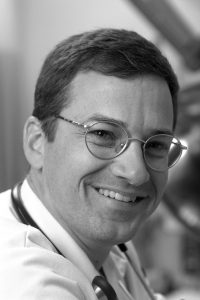
In 2015, Dr. Bruce Liang, by then the medical school dean, appointed Fuller as Jacobs’ successor, and they created a Department of Emergency Medicine to further align UConn Health with the rest of the national academic community.
By 2016, the continuing expansion of the John Dempsey Hospital Emergency Department culminated with the opening of the University Tower, which included a modern, multi-zoned, 40-bed ED.
Fuller intends to continue seeing patients in that ED on occasional weekends for the foreseeable future, and remains available as a mentor to his clinical and academic successors in UConn Health emergency medicine. He also plans to continue volunteering with the International Medical Corps, which deploys physicians to disasters around the world.
Toward the end of his tenure as chair, Fuller reflected on the evolution of emergency medicine, both in general and specifically at UConn Health, as well as the direction it’s heading.

What was your vision when you became chair of emergency medicine in 2015?
I think the chair job, if it’s done right, is about developing your faculty. You have to make sure you have the right people to both take care of patients and take care of learners. That’s the bulk of it. So on any one given day, I might put on a hat to strategize about moving into a new emergency department when we build our new hospital, helping design and draw that, and working with the team of people to get the new emergency department. Then there might be an opportunity in the medical school that comes up and I’ll have a faculty member who I think is perfect for that job, and so I’ll advocate for that faculty member so they can expand their career. So I’m trying to make those connections happen as a chair.
The people you’re turning this over to, how much of a factor was that in your decision and the timing of it?
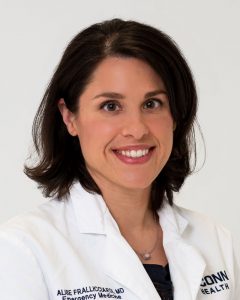
When I became chair, I set a clock to do it for 10 years. For years I’ve been working to leave. I’ve been fostering the next generation of leaders and doctors, and diversifying and maturing my faculty.
Succession planning has been a big piece of my last three years in particular, and working with Bruce [Liang] and Andy [Agwuonobi, UConn Health CEO], I’ve been getting them acquainted with my succession plan. The new interim chair, Alise Frallicciardi, she and I have talked about this for four or five years, about how I think that she’d make a great chair, and she’s been thinking about how her leadership in emergency medicine can grow. She and I were working with purpose to develop her. She’s got a great personality and work ethic, and ethics and skills, and her portfolio is super strong now. So I do think that makes it possible for me to step aside.
For me, the marker of success for a chair is getting out of the chair role and leaving your department whole and functioning and moving forward.
How have you observed emergency medicine changing and evolving since your arrival in 1996?
Emergency medicine was evolving in the late 80s. When I applied for residency, they did not have a board certification. They did not have fellowships back then. It was a new specialty, so we were learning. There were a small number of residencies established around the country at the time. When I arrived, UConn had its first year of emergency residents just starting.
Emergency medicine was not like it is today. As a physician, the emergency department was a place you passed through on your way to your anesthesia career or your cardiology career or your surgery career, it wasn’t a place where you sat down and stayed.
They were largely run by residents and some remotely supervising specialists. That’s in an academic place like here. But then community hospital emergency departments were kind of like, the new internal medicine doctor who comes to town and wants to start building a practice would sign up to work in the emergency department and take care of patients, and then say, “Hey, by the way, if you don’t have a doctor, come to my office.” And they would do that for a handful of years until their office was filled and then they would stop doing it.
They would have no idea how to take care of the pediatric case, because they weren’t trained in that, or the surgical case or the ophthalmology case or OB-GYN case. Then the cardiologist would be moonlighting to build up his practice and he wouldn’t know what to do with the appendicitis. So there was this kind of gap that we had as a society, that having that doctor who knew a little bit of all the trades wasn’t really built yet. Most of the doctors weren’t trained in emergency medicine.
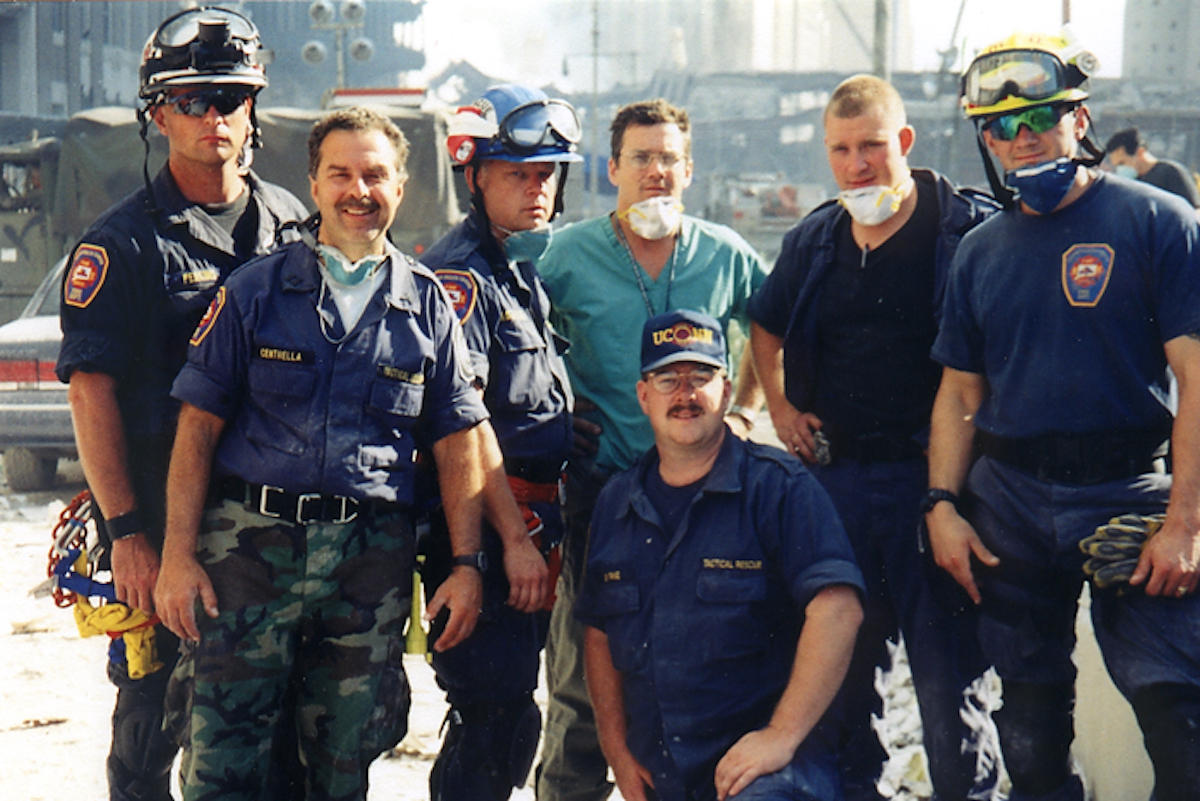
And from a patient flow standpoint?
Another way emergency medicine has changed is, we’ve kind of evolved into the diagnostic area of the hospital in many ways. Frankly, it used to be that admitting people to the hospital was an easier thing to do. Now admitting people to hospital requires a lot of thought. That decision whether or not to admit is a huge responsibility, and that ends up being the emergency doc’s responsibility. We’ll do it in collaboration with partners, of course, but most of those decisions we’re making on our own, and it’s a weighty decision.
In the 70s and 80s, if you had abdominal pain, you just got admitted into the hospital. They’d watch you in the hospital for a few days, and if you got sicker, they would operate on you, and if you didn’t get sicker, they’d send you home. Now, we’ve got to have the exact answer, and the exact diagnosis and the exact right disposition for the person. We come to the diagnosis.
The diagnostic tools weren’t as good as they are now. But also, the emergency departments weren’t as good as they are now, so they would just put people in the hospital. Now, you come in the hospital, you get through a pretty hefty investigation in the emergency department and you really know where you’re going before you get to the hospital.
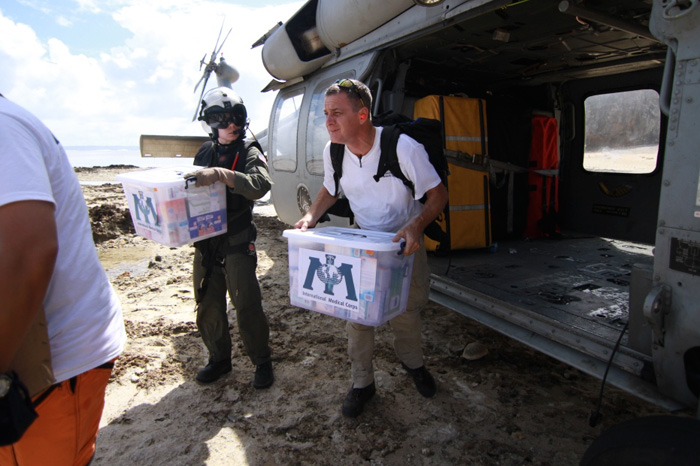
Laboratory testing is better, more specific, faster, quicker, more accurate, and then, in our own hands, ultrasound at the point of care. It’s not a complete radiology ultrasound, it’s a totally different beast. This is an ultrasound to ask a very specific question that I have in my mind right now. Ultrasound was very rudimentary when I was a resident, and to see what we do now with ultrasound delivered at the point of care, that’s been a real change. It’s saved lives, no doubt.
That diagnostic area has become kind of our thing. It’s kind of fun; that’s like the detective part of medicine. “I don’t know what’s wrong with you, but let’s try to figure it out,” and we only have a glimpse of the patient, you don’t get to see them for hours and days. Personal history is going to be tiny, because we’re just meeting with them, though nowadays with electronic medical records we can investigate their history a little better.
But that was the evolution to me, kind of professionalizing it. That is, having people do it who are trained to do it.
What does the future of emergency medicine look like to you?
Complicated people have nowhere else to go. A complicated person is somebody who’s on an immunosuppressant drug of some sort, for whatever reason, for their psoriasis, for their arthritis, for their Crohn’s disease. That could be someone who looks healthy, but they’re on a drug like that and they have a fever or a cough or a stomachache; they call up their doctor and their doctor’s going to say, “I can’t take care of you. You’re complicated.” Because they are — they could just have a stomachache or just a cough, but they could be dying and there’s no way the doctor’s office can sort that out.
The future is more of society will be complicated, whether that’s highly functional people in their young middle age who are on medications that make them frail, or for the next 20 years or so, the Baby Boomers who are complicated, because they’re 70 and are on multiple medications, or they’re 80 and they’re mowing the lawn. When they say, “Doctor, I have” fill in the blank, it could be God knows what, you’d better go to the emergency department, where we have the diagnostic tools to sort that out.
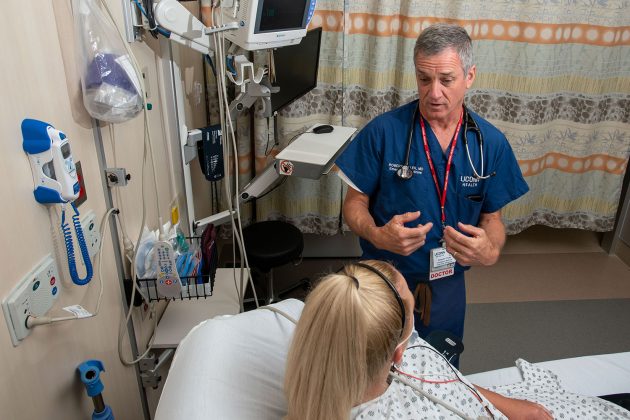
I think the future is caring for more complicated patients, whose bodies are harder to evaluate at a glimpse. And we’ll need more space to do that care, and we’ll be a valuable piece of the health care environment. I don’t paint it as a bleak future, I paint it as a crowded future we could anticipate.
How might artificial intelligence fit into that future?
I think AI can be an aid to decision making and an aid to chart completion. A complicated patient can show up and might have 800 pages of records. You can’t expect me as a single human to read all of those pages and interpret them, and then be fully prepared to take care of that patient. If I have to take care of two patients this hour, and I’ve got one patient that requires two days’ worth of reading, I can’t fit that much intellectual demand into that one space.
So maybe there’s a role for AI, where you can say, here’s an AI summary of the critical events in the patient’s past 10 years of health care, and now it’s digested down to a one-page summary that you can delve into further if you need to. It might set me up for success, rather than have, “If only I looked at the urology note from four years ago, I would’ve known.”
And maybe there’s a place for AI to make note-creation work a little easier, it could be on my shoulder watching what I do and then put together a note that shows what I did and what I thought and what I said, and turn it into a reasonable document that the next provider could look at and say, “Oh yeah, I get what Rob did.” So that might be a place medicine is going.
How did you find your way to emergency medicine?
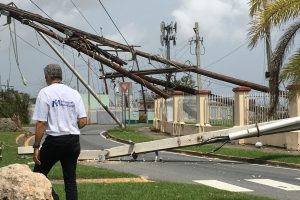
In medical school — I went to Loyola Medical School in Chicago — they didn’t have an emergency medicine residency there. They had an old-fashioned emergency department staffed by residents on call, that kind of thing. They had no training for anyone there in emergency medicine. But when I was a senior medical student, I did an away rotation in St. Lucia, at the St. Jude Hospital in Vieux Fort, a surgery rotation.
The coolest part of being in St. Lucia was in the evenings, after the surgery and the pediatrics and the internal medicine clinics closed, they opened up a place called the “accident ward.” And people would just show up with random problems, and all night long you could just see people coming in with their problems and diagnose them at this accident ward. I thought that was a blast.
I hadn’t realized yet there was a specialty called emergency medicine. So I looked around; there were a handful of emergency residency medical programs to apply to, and I got to go to one. It was a three-year program at the Hennepin County Medical Center in Minneapolis.
What was next, before coming to UConn Health?
I took a year and went back to St. Lucia to work at that hospital as a volunteer and help them build an emergency department. I got to do a lot of tropical medicine and austere, or low-resource, medicine. But I got to work with the nurses and doctors down there to help them build the concept of emergency medicine. And we built a building at the front of the hospital and we put together the protocols for how to take care of a trauma case, how to take care of a pediatric critical case, how to take care of an adult critical case. We had some bays and a triage process, and we set up a little emergency service line there.
One of the things I wanted to do at UConn was to take residents and medical students back to St. Lucia every year to experience this kind of low-resource tropical medicine health care setting, where I had some friendships and some roots now. I would do 12 months of work in 11 months’ worth of time here, and I would take one month and I’d go with UConn medical students or residents down to St. Lucia and we’d work at this hospital, so the students and residents could have an experience there and I could kind of continue to fan the flames of emergency medicine down there. And so I did that every year for maybe 18 years.

And here we see the seeds of what you eventually would be doing with disaster response all over the world. You’re planning to continue working with the International Medical Corps?
Yes, more so, if I can, if they’ll have me.
Between disaster response and training, you’ve had at least a dozen missions with IMC. How did that come to be?
One of the emergency medicine residents I became friends with in St. Lucia, Matt Howell, we worked very well together. He’s an emergency medicine doctor and he also enjoyed doing this low-resource tropical medicine work. When the earthquake and tsunami happened in Indonesia [December 2004], he called me up: “Rob, this seems like the kind of thing we’re perfect for. We should try to go respond to this.” I hadn’t even thought of it. We reached out to several different agencies. I did an interview over the phone with the International Medical Corps intake person, told them what I was and what my friend Matt was and what we might like to do, and they’re like, “You guys sound great.” And so we packed up and headed there.
I’d already done a lot of tropical medicine and a lot of “there’s no water or electricity today, but we have to do surgeries, how are we going to do it” kind of discussions. That’s how the relationship with the International Medical Corps got started. It was a good match.
So we had a good response together there, and it started that relationship where it’s like, “There’s a disaster, I wonder if Rob’s available, let’s see what he’s doing.”
After several of these overseas disaster responses, you started a specific fellowship for this type of training. How far into that are we?
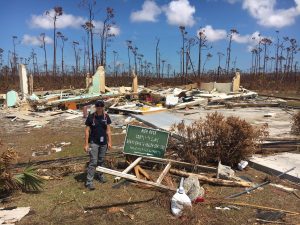
The International Disaster Emergency Medicine Fellowship is a two-year program, one fellow per year. Four have finished, and five and six are in the pipes. I turned that over two years ago to Natalie Moore, MD. She was the inaugural fellow. Besides the fact that she’s got a great spirit and incredible capability, and is going to be better at it than I ever was, she’s now program director for a few years and is in position to continue to advance professionally.
Another case of growing the people who will follow you?
I’m still available to her, and I’ll be available to her for as long as she needs. It’s part of the thing of, let’s train up the next generation so that when I’m not doing it, she’s been doing it already for years. We have a partnership in this and she knows I’m going to continue to support it. But she should have the title and do that leadership work, so that she can “grow up.” And I can coach her or cover her vacation. But it’s a good example of giving it to the next generation while they’re in their formative years.
Speaking of the next generation, what about the next generation of your own family? Your oldest daughter is an emergency medicine resident in Florida, your middle daughter is an ED nurse in New Hampshire, and your youngest is a medical student here. Was medicine always the expectation growing up in the Fuller house?
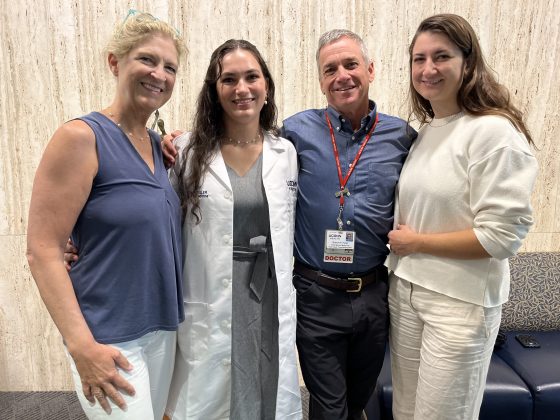
No, totally not an expectation. I never told them to do medicine. I showed them medicine, they watched me live the life, but they always got to choose what they were going to do. I always took a positive look at medicine for my kids, and I would tell them things like, “It’s a great way to spend time on the planet, taking care of patients.” And they saw that, sure, medicine spilled onto the dining room table, it was at home, so very invasive, but I still think it’s an enjoyable career even though it’s a hard career. So anyway, my kids chose it on their own for sure. My girls have enjoyed it the way I enjoyed it — yeah, it’s hard fun, but it’s fun.
Between your efforts to build UConn Heath emergency medicine to what it’s become, your work around the world to deliver medical care under challenging conditions, and your raising of three daughters who have chosen careers in medicine, it’s clear that leaving the world a better place is important to you. Whether you want to admit it or not, that’s quite a legacy. Are you, or will you be, able to reflect on that?
I do enjoy it. I try to play it down, but I’m proud of my daughters. I like what they do. I’m proud of my department and how well we are situated.
But I would never take all the credit for any of that. My wife’s contribution to our kids’ development is huge, and their peers and the other pieces, but they are doing good stuff, which makes me really happy. It’s cool to watch your kids go off and do nice things.
What drives your ambition?
Service before self is a piece of the mantra of doing emergency medicine. It’s like, you take care of the patient before you go eat your crackers, because they need you first.
Latest UConn Today
- UConn Medical Students Learning to Strike Out Organ Donation InequitiesNew England Donor Services Launches New Medical Student Summer Immersion Program to Advance the Future of Organ Donation and Transplant Equity.
- UConn’s Institute for Collaboration on Health, Intervention, and Policy Recognizes Faculty Research ExcellenceInCHIP Excellence Awards celebrate UConn and UConn Health faculty who are advancing their field, providing impactful mentorship, and engaging with communities to improve health outcomes.
- AI in K-12 Education: Partners in Progress, Not ReplacementsAs artificial intelligence continues to transform industries worldwide, educators and researchers with the Neag School of Education are exploring how it may reshape teaching and learning
- UConn Magazine: All Together NowThat connection you feel with fellow fans at the game? It’s even more powerful than you think
- MFA Acting Alum Makes Name for Himself as Cast Member on ‘The Chosen: Last Supper’'Everything moved into place. It felt like prayers being answered'
- Demystifying the Link Between Major Depression and Alzheimer’s DiseaseUConn investigators uncover new risk factors linking depression and dementia













